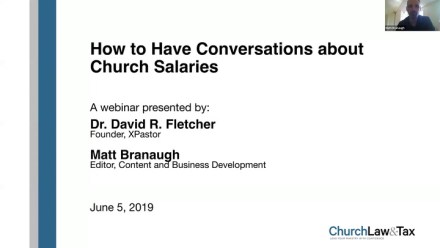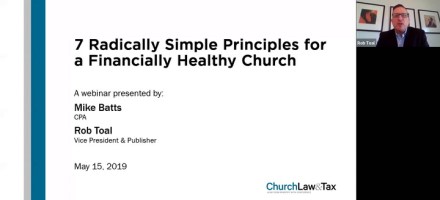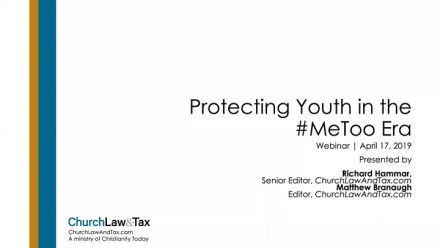Q: Our church allows a homeschooling organization to meet in our facility one day per week during the school year. In return, the group makes a donation to the church to help us cover the costs of electricity and water. I recently heard that such an arrangement puts our church’s property tax exemption in jeopardy. Is this true?
First, classifying such payments as a “donation” does not necessarily resolve the question, since the Internal Revenue Service (IRS) may conclude that the “donation” is actually rent paid to the church for the use of its facilities. The IRS often says that it is the “economic reality” that controls, not terminology.
Second, whenever a church is considering the rental of some or all of its facilities, there are a number of factors to be considered. Your question is actually one of seven questions that merit attention by your church leaders when weighing arrangements like this one:
1. Would receiving rental income impact our church’s tax-exempt status?
No, so long as the rental activity is insubstantial in nature. Unfortunately, neither Congress nor the IRS has defined “insubstantial.”
2. If receiving rental income does not impact our tax-exempt status, would our church be required to file a tax return and pay taxes on the rental income?
Only if the income represents unrelated business taxable income.
Federal law imposes a tax (equal to the corporate income tax) on the net income generated by a tax-exempt organization from any unrelated trade or business that is “regularly carried on.” This tax is called the unrelated business income tax (or UBIT, for short). Rental income derived from debt-financed property generally constitutes unrelated business taxable income unless the property falls within certain exceptions.
For example, if substantially all (85 percent or more) of the use of any property is substantially related to a church’s exempt purposes, the property isn’t treated as debt-financed property. Related use doesn’t include a use related solely to the organization’s need for income.
If less than 85 percent of the use of the property is devoted to exempt purposes, only that part of the property that is not used to further exempt purposes is treated as unrelated debt-financed property.
Even if a church’s rental activities are subject to the tax on unrelated business income due to the property being debt-financed, there are three additional observations to note. First, the tax is a prorated tax.
This means that only a portion of net rental income is taxable. The taxable portion of net income is determined by multiplying both the revenue and the applicable expenses by a ratio—average acquisition indebtedness during the year divided by the average tax basis of the property during the year. Acquisition indebtedness is debt incurred in connection with the purchase or improvement of the property.
For example, if the average acquisition indebtedness on the rented property during the year were half the property’s tax basis, then only half of the net rental income is subject to the unrelated business income tax. (Half of the revenue and half of the expenses would factor into the calculation.)
Second, the tax is assessed against net income from the taxable rental activity. This means the church is entitled to deduct applicable expenses. This would include a number of items, including an allocated portion of insurance, utilities, custodial services, and so on. Third, there is a $1,000 exclusion, meaning that the first $1,000 of net taxable income is excluded from tax.
A Form 990-T must be filed with the IRS if your church generates $1,000 or more of gross income from an unrelated trade or business.
3. Would allowing a for-profit entity to use church property threaten the church’s property tax exemption?
Possibly, depending on the state in which you live. See Table 12-4 in my annual Church & Clergy Tax Guide for the relevant sections of the property tax exemption statutes of all 50 states.
Note that in some cases the full or partial loss of your church’s property tax exemption may be avoided if the “rent” is characterized as a “facilities use fee” that is designed to recover the costs to the church of providing the property. You will have to check with the tax assessor or a real estate attorney about this.
4. What about liability concerns?
You must assess the increased risk of legal liability associated with the rental of your property. Some risks may be too great to even consider, especially when you consider the relatively modest rental income that will be received. Any rental activity involving minors represents the highest risk. The lessee must provide evidence of insurance in an amount that is acceptable to you. The church should be listed on the lessee’s liability policy as a named insured. You also should check with your church insurer about additional coverage under your policy.
5. Is the rental activity a permitted use under our church’s zoning classification?
Your church needs to verify that the use of its property by an outside group is permissible under zoning law. For example, if you rent your property to a childcare provider, is this a permitted use in your zoning classification? Possibly not. You will need to check with your local zoning authorities, or an attorney, about this.
6. Should we require the outside group to sign a facilities use agreement?
It is possible for a church to be liable for injuries that occur during the use of its premises by an outside group since it is the owner of the premises. This risk can be reduced by adopting various precautions, including the following:
- Have the outside group sign a “facilities use agreement” that (1) provides the group with a mere license to use the property, (2) contains a hold harmless and indemnification clause, and (3) states that the church provides no supervision or control over the property when being used by the group. This document should be prepared by an attorney.
- Have the church named as an additional insured under the group’s liability policy.
- Review the group’s liability policy to ensure that it provides adequate coverage and does not exclude sexual misconduct.
- If the group’s activities will involve minors, have a written acknowledgment from the group that all workers have been adequately screened. Fifth, check with the church insurer to determine coverage issues in the event the church is sued as a result of an accident or injury occurring during the group’s use of the property.
7. Will allowing outside groups to use our church building subject us to public accommodations laws?
It is possible. An activity like this one by your church may make it subject to local, state, and federal public accommodations laws, but it requires a more detailed analysis. You can find more insights in my ChurchLawAndTax.com article addressing a key decision by a federal court in Idaho. Your church also will want to consult with a qualified local attorney who can review the language of the relevant statutes and analyze them in relation to your church’s activities.
The bottom line is that the rental of your church property raises a number of important questions, and may expose the church to significant liability. You must decide if all of these risks are worth the minimal amount of rent that your church will receive.
One final thought: Sometimes a church allows groups to use its facilities free of charge. Doing so can still expose a church to a number of the concerns outlined above—such as local zoning requirements and various liability issues.
Get more help with navigating the use of your church building by outside groups through the downloadable resources Managing Church Facility Use , Understanding Church Insurance, and Church Issues: Same-Sex Marriage and Gender Identity.



















